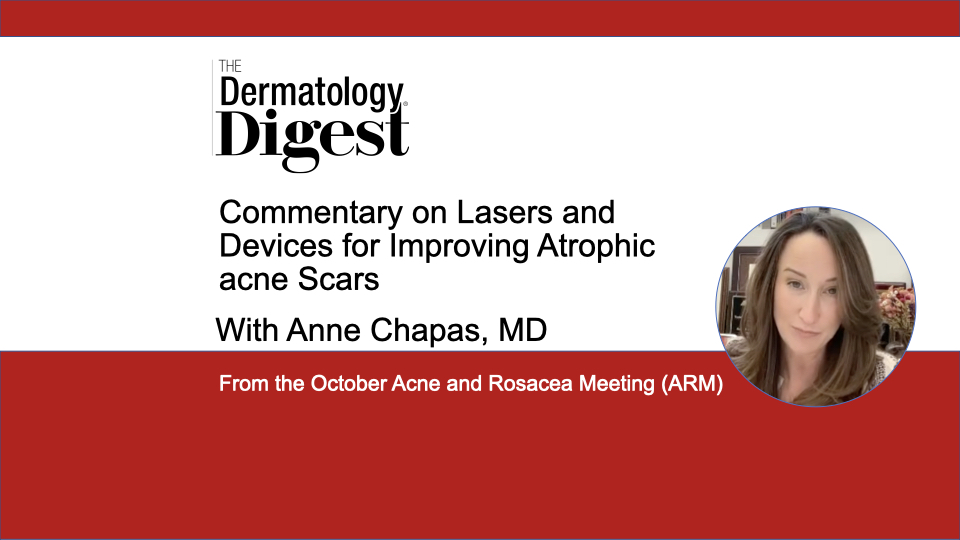Dr. Anne Chapas discusses evaluating and treating acne scars, including energy device and surgical options.
Anne Chapas, MD, is Director of UnionDerm and Instructor of Dermatology, Mount Sinai Medical Center, New York, New York.
“In addition to dealing with the treatment of acne and rosacea, we spend a lot of time also discussing the sequela… which is usually dealing with the aftereffects of the redness, the scarring, [and] the dispigmentation that can happen even once someone’s acne or rosacea improves,” said Anne Chapas, MD, who discussed acne scars and treatment options in her presentation “Lasers and Devices for Improving Atrophic Acne Scars” at the October Acne and Rosacea Meeting (ARM).
“It’s really first important to know that your patients will have a variety of scars… then thinking about the different devices and which one’s better with which type of scarring.”
Scar types include rolling, boxcar, ice pick, keloid, and papular.1
“The first step is to assess your patient, what their goals are, what types of scars you’re treating, and then come up with a treatment plan.”
Decades ago the standard acne scar treatment was dermabrasion, said Dr. Chapas.
“And although that helped some patients, it was not an option for patients with darker skin types because it led to whitening of the skin, and it sometimes even caused more scarring.”
More recently, ablative and nonablative fractional laser resurfacing devices became an integral part of the dermatologist’s treatment armamentarium.
“[Fractional lasers] are the go-to treatments now for patients with more rolling or boxcar-type scars, and patients can expect an improvement anywhere from 25% to 75% after a series of treatments.”
The past few years have also brought microneedling and radio frequency modalities into the acne treatment fold, said Dr. Chapas.
“They go a little deeper than the nonablative and the ablative fractional resurfacing devices… and they sometimes even have less recovery time… so I tend to use both of those in my practice.”
Of the various scar types, the “v” formation of the icepick scar makes treatment particularly challenging, said Dr. Chapas.
“Energy and laser-based devices are not great at really getting down to the bottom of that.”
Other treatments are generally more effective for ice pick scars, including the CROSS technique with TCA, punch excisions, or subcision. These can also be combined with laser energy devices as part of the treatment plan, she said.
Dr. Chapas offers the following tips for treating acne scars:
1. Treat newer scars, when possible.
“I think it’s important to talk to your patients about this early. We all see acne patients every day, and realizing that scar treatments are more successful in new scars rather than older scars [is important],” said Dr. Chapas
2. Modify energy and density to reduce risk of PIH.
“[Ablative and non ablative fractional, PICO, and RF needling devices] can be used in darker skin types to successfully improve the appearance of acne scars. They have to be slightly modified as far as sometimes the energy and density to reduce the risk of the complication of postinflammatory hyperpigmentation, but all of these devices have been quite successful in patients of all skin types.”
3. Start smart when adding scar treatment modalities to your practice.
“If you are going to purchase one of these capital equipment devices, you should realize that acne scars are not the only indication, so you should really buy a device that fits your practice and the (additional) indications that you might use it for.”
According to Dr. Chapas, “[Microneedling pens] take multiple treatments, but they’re less expensive as a startup cost.”
TCA CROSS and subcision are also low-cost techniques available to dermatologists who may not be ready to make a capital equipment investment, she said.
Reference:
- Jacob CI, Dover JS, Kaminer MS. Acne scarring: a classification system and review of treatment options. J Am Acad Dermatol. 2001; 45(1):109‐ 117.


